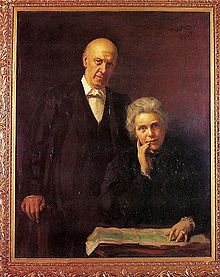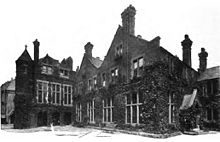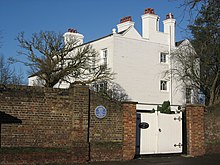Henrietta Barnett
Henrietta Barnett | |
|---|---|
 Samuel and Henrietta Barnett portrait by Hubert von Herkomer in Toynbee Hall | |
| Born | Henrietta Octavia Weston Rowland 4 May 1851 Clapham, London, England |
| Died | 10 June 1936 (aged 85) Hampstead, London, England |
| Nationality | British |
| Occupation(s) | Humanitarian, educator, author |
| Spouse | Samuel Barnett |
Dame Henrietta Octavia Weston Barnett, DBE (née Rowland; 4 May 1851 – 10 June 1936) was a notable English social reformer, educationist, and author. She and her husband, Samuel Augustus Barnett, founded the first "University Settlement" at Toynbee Hall (in the East End of London) in 1884. They also worked to establish the model Hampstead Garden Suburb in the early 20th century.
Early life
Born in Clapham, London, Henrietta Octavia Weston Rowland lost her mother (Henrietta Monica Margaretta Ditges)[1] at an early age. Her father, Alexander William Rowland, a wealthy businessman associated with the Macassar Oil Company,[1] raised her and seven siblings at their London home and a country house in Kent, where she developed a lifelong appreciation of country pursuits. One of her sisters was the philanthropist Alice Hart.[2][3]
At age 16, Henrietta was sent to a boarding school in Devon run by the Haddon sisters, who, influenced by James Hinton,[1] were committed to social altruism. When her father died in 1869, Henrietta moved with two sisters to Bayswater, where she met and helped social activist and housing reformer Octavia Hill.[3] Hill introduced Henrietta to the writings of John Ruskin, as well as many influential people similarly interested in improving the condition of London's poor.
Marriage and activism
Through Hill, Henrietta met Canon Samuel Barnett, then the curate of St Mary's, Bryanston Square. They married in 1873. The newlyweds soon moved to the impoverished Whitechapel parish of St Jude's, intent on improving social conditions. Henrietta continued her parish visiting activities, with a focus on women and children, including the more than 2,000 prostitutes then active in Whitechapel alone.[2] In 1875, Henrietta became a woman guardian for the parish, and the following year was named a school manager for the Poor Law district schools in Forest Gate. Another social initiative which the Barnetts helped set up was the Metropolitan Association for Befriending Young Servants (1876), with Jane Senior; the organisation aimed to prevent girls from becoming prostitutes, criminals or alcoholics, and provided domestic servants.[1] The Barnetts' experiment in sending slum children for country holidays grew into the Children's Fresh Air Mission (Off to the Country), established in 1877,[1][4] becoming the Children's Country Holidays Fund in 1884.[5] Henrietta Barnett promoted Homes for Workhouse Girls starting in 1880, and founded the London Pupil Teachers Association in 1891. She also served as vice-president of the National Association for the Welfare of the Feeble-Minded (1895) and National Union of Women Workers (1895–96).

In 1884, the Barnetts established (and began living at) Toynbee Hall, a pioneering university settlement named after the recently deceased distinguished historian Arnold Toynbee,[6] who had advocated education of the working classes and reduction of the division between social classes. In 1897 annual loan exhibitions of fine art began at the nearby Whitechapel Gallery through the Barnetts' efforts. In 1903 Richard Tawney began working with them, the Children's Country Holiday Fund, and the Workers' Educational Association. William Beveridge and Clement Attlee also worked with the Barnetts as they started their own careers. A visit to Toynbee Hall inspired Jane Addams to found Hull House in Chicago.


In 1889 the activist couple acquired a weekend home at Spaniard's End in the Hampstead area of north-west London. The Barnetts became inspired by Ebenezer Howard and the model housing development movement (then exemplified by Letchworth garden city), as well as protecting part of nearby Hampstead Heath from development by Eton College. In 1904, they established trusts which bought 243 acres of land along the newly opened Northern line extension to Golders Green. This became the Hampstead Garden Suburb, a model garden city developed through their efforts and those of architects Raymond Unwin and Sir Edwin Lutyens and which ultimately grew to encompass over 800 acres.[7] In 1909, an adult education institute opened in the middle of the new Hampstead Garden Suburb, with cultural programmes and discussion groups. Soon a school for girls was established and named the Henrietta Barnett School.[3]
Although the suburb was never completely developed according to Lutyens's plan (and soon became a middle class enclave rather than a mixture of classes), it did include Grade I listed St Jude's Church, as well as a clubhouse and a tea house (for non-alcoholic social focus), a Quaker meeting house, children's homes, a nursery school, and housing for old people. [citation needed]
The Barnetts never had children of their own. They adopted Dorothy Woods, and Henrietta also served as legal guardian for her brain-damaged elder sister, Fanny. After Samuel died in 1913, Henrietta founded Barnett House at Oxford (1914) in his memory. She helped it become the university's centre for social work and social policy education.[citation needed]
Writing
Barnett wrote several books, alone and with her husband.[8] Their Christian Socialist beliefs are set out in Practicable Socialism (1889) and Toward Social Reform (1909).
Her early books concerned domestic issues: The Making of the Home (1885), How to Mind the Baby, (1887) and, written with her husband and Ernest Abraham Hart (her brother-in-law), The Making of the Body (1894). With Kathleen Mallam, Henrietta Barnett also edited a collection of essays entitled Destitute, Neglected, and Delinquent Children (Pan-Anglican papers, 1908). After her husband's death, Henrietta Barnett finished their Illustrated British Ballads Old and New (1915), wrote his multi-volume biography, Canon Barnett: his life, work and friends (1918) as well as published collections of essays, most notably Matters that Matter (1930). [citation needed]
Honours
For her work as a social reformer, Barnett was named a Commander of the Order of the British Empire in 1917, and elevated to Dame Commander of the Order of the British Empire (DBE) in 1924. In 1920, she was named honorary president of the 480 member American Federation of Settlements.

Death and legacy
For the final dozen years of her life, Henrietta Barnett took up painting and often lived at 45 Wish Road, Hove (today marked by a blue plaque).
She died at Hampstead in 1936 (aged 85) and is buried (with Samuel) in the churchyard of St Helen's Church, Hangleton, East Sussex.[9]
The Barnetts are jointly remembered on 17 June on the liturgical calendar of the Church of England.
References
- ^ a b c d e Simkin, John. "Henrietta Barnett". Spartacus Educational. Retrieved 16 January 2017.
- ^ a b "Henrietta Barnett in Whitechapel a review by Chris Kellerman". Hgs.org.uk. Retrieved 29 March 2016.
- ^ a b c "Henrietta Barnett, social reform and community building". Infed.org. Retrieved 29 March 2016.
- ^ Children's Country Holiday Fund, Retrieved 14 January 2017
- ^ "Our History". CCHF - All About Kids. Retrieved 16 January 2017.
- ^ Seth Koven, ‘Barnett , Dame Henrietta Octavia Weston (1851–1936)’, Oxford Dictionary of National Biography, Oxford University Press, 2004; online edn, Sept 2013 accessed 14 Jan 2017
- ^ "Archived copy". Archived from the original on 6 December 2013. Retrieved 15 January 2014.
{{cite web}}: CS1 maint: archived copy as title (link) - ^ "BARNETT, Mrs. (Henrietta Octavia)". Who's Who. Vol. 59. 1907. p. 97.
- ^ Dale, Antony (1989). Brighton Churches. London EC4. p. 227. ISBN 978-0-415-00863-1.
{{cite book}}: CS1 maint: location (link) CS1 maint: location missing publisher (link)
Published works
- Barnett, Henrietta Rowland (1885). The Making of the Home. A reading-book of domestic economy for school and home use. London: Cassell and Company.
- Barnett, Henrietta Rowland (1894). The Making of the Body. A children's book on anatomy and physiology : for school and home use. London: Longmans, Green.
- Barnett, Henrietta O. (Mrs. S. A. Barnett) (1881). The Work of the Lady Visitors: Written For The Council of the Metropolitan Association for Befriending Young Servants [1]. London: Penny and Hull.
- Barnett, Henrietta O. (Mrs. S. A. Barnett) (1879). The Young Women In Our Work Houses [2]. London: Penny and Hull.
- Barnett, Samuel Augustus; Barnett, Henrietta Rowland (1888). Practicable Socialism: Essays on Social Reform (1st ed.). London: Longmans, Green & Co.
- Barnett, Samuel Augustus; Barnett, Henrietta Rowland (1895). Practicable Socialism: Essays on Social Reform (2nd ed.). London: Longmans, Green & Co.
- Barnett, Samuel Augustus; Barnett, Henrietta Rowland (1915). Practicable Socialism: Essays on Social Reform (New Series ed.). London: Longmans, Green & Co.
- Barnett, Samuel Augustus; Barnett, Henrietta Rowland (1909). Towards Social Reform. London: T. Fisher Unwin.
- Barnett, Henrietta Rowland (1919). Canon Barnett: His Life, Work, and Friends. Houghton Mifflin.
- Barnett, Henrietta Rowland (1930). Matters that Matter. London: J. Murray.
Further reading
- Hartley, Cathy; Susan Lecky (2003). A Historical Dictionary of British Women. London and New York: Europa Publications. ISBN 978-1-85743-228-2.
- Creedon, Alison (2006). 'Only a Woman' Henrietta Barnett: Social Reformer and Founder of Hampstead Garden Suburb. Chichester: Phillimore.
- Koven, Seth (2004). 'Dame Henrietta Octavia Weston Barnett' in Matthew, H. C. G. and Harrison, B. (eds.) Oxford Dictionary of National Biography Volume 3. Oxford: Oxford University Press.
- Robbins, Sarah Ruffing. "Sustaining Gendered Philanthropy Through Transatlantic Friendship: Jane Addams, Henrietta Barnett, and Writing for Reciprocal Mentoring in Philanthropic Discourse." Anglo-American Literature, 1850 - 1920, edited by CHRISTIANSON F. Q. and THORNE-MURPHY LESLEE, Indiana University Press, Bloomington, Indiana, 2017, pp. 211 - 235. Retrieved February 13, 2020, from www.jstor.org/stable/j.ctt.2005sg6.14. [3]
- Slack, Kathleen M. (1982). Henrietta's Dream: A Chronicle of Hampstead Garden Suburb 1905–1982. London.
{{cite book}}: CS1 maint: location missing publisher (link) - Watkins, Mickey (2005). Henrietta Barnett in Whitechapel: Her First Fifty Years. London.
{{cite book}}: CS1 maint: location missing publisher (link)
External links
- 1851 births
- 1936 deaths
- British educational theorists
- British humanitarians
- British philanthropists
- Dames Commander of the Order of the British Empire
- People from Clapham
- People from Hampstead
- British women writers
- Disease-related deaths in England
- British reformers
- British social reformers
- People from Whitechapel
- National Council of Women of Great Britain members
